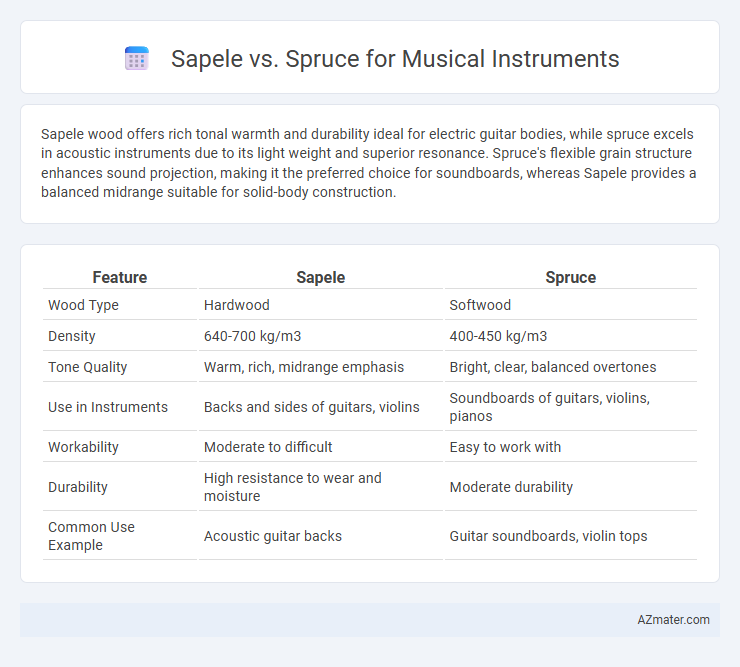Sapele wood offers rich tonal warmth and durability ideal for electric guitar bodies, while spruce excels in acoustic instruments due to its light weight and superior resonance. Spruce's flexible grain structure enhances sound projection, making it the preferred choice for soundboards, whereas Sapele provides a balanced midrange suitable for solid-body construction.
Table of Comparison
| Feature | Sapele | Spruce |
|---|---|---|
| Wood Type | Hardwood | Softwood |
| Density | 640-700 kg/m3 | 400-450 kg/m3 |
| Tone Quality | Warm, rich, midrange emphasis | Bright, clear, balanced overtones |
| Use in Instruments | Backs and sides of guitars, violins | Soundboards of guitars, violins, pianos |
| Workability | Moderate to difficult | Easy to work with |
| Durability | High resistance to wear and moisture | Moderate durability |
| Common Use Example | Acoustic guitar backs | Guitar soundboards, violin tops |
Overview of Sapele and Spruce as Tonewoods
Sapele is a durable hardwood known for its rich, warm midrange tones and natural sustain, commonly used in acoustic guitar back and sides for a balanced sound with pronounced depth. Spruce, prized for its lightweight and stiff properties, delivers a bright, clear, and dynamic tonal quality, making it a preferred choice for the soundboard or top of many stringed instruments. Both tonewoods contribute distinct sonic characteristics: Sapele enhances warmth and resonance, while Spruce offers clarity and projection.
Physical Properties: Grain, Density, and Appearance
Sapele wood features a fine, interlocked grain with a medium density of about 640 kg/m3, offering a rich reddish-brown appearance that darkens over time, making it popular for guitar bodies and necks due to its durability and aesthetic appeal. Spruce is known for its straight, even grain and low density around 400-450 kg/m3, providing a lightweight yet strong soundboard material prized for its excellent resonance and bright tonal qualities in acoustic instruments. The contrast in density gives Sapele a warmer, more balanced tonal output, while Spruce delivers pronounced clarity and projection, influencing the choice between these woods based on desired sound and visual characteristics.
Sound Characteristics: Warmth vs. Brightness
Sapele wood produces a warm, rich tone with pronounced mids and a smooth, balanced resonance ideal for guitars and ukuleles, enhancing warmth in musical instruments. Spruce offers a bright, clear sound with strong articulation and excellent projection, making it a preferred choice for soundboards in acoustic guitars and violins. The warmth of Sapele contrasts with the brightness of Spruce, influencing tonal color and playing style preferences.
Durability and Lifespan in Musical Instruments
Sapele wood offers superior durability and a longer lifespan compared to spruce, making it a preferred choice for musical instrument bodies such as guitars and ukuleles. Spruce, commonly used for soundboards, provides excellent tonal qualities but is more prone to dents and environmental wear over time. Instruments constructed with sapele tend to maintain structural integrity under varying humidity and temperature conditions, ensuring sustained performance and longevity.
Suitability for Different Types of Instruments
Sapele wood, with its dense grain and warm tonal qualities, is highly suitable for acoustic guitars and ukuleles, providing a rich midrange sound and enhanced sustain. Spruce, renowned for its lightweight and responsive nature, is the preferred choice for soundboards in violins, classical guitars, and mandolins, delivering bright, clear tones and excellent projection. The difference in hardness and resonance makes sapele ideal for body construction, while spruce excels in soundboards requiring dynamic sensitivity.
Workability for Luthiers and Manufacturers
Sapele offers excellent workability for luthiers, with a fine grain and moderate hardness that allows for precise carving and shaping, making it suitable for guitars, ukuleles, and other stringed instruments. Spruce, particularly Sitka or Engelmann varieties, is prized for its exceptional strength-to-weight ratio and ease of planing, crucial for creating resonant tops with delicate bracing structures. Both woods provide reliable machining properties, but Sapele's stability and resistance to splitting give manufacturers an advantage in durability-focused instrument components.
Cost and Availability in the Market
Sapele wood generally costs more than spruce due to its rich grain and aesthetic appeal but remains widely available in global markets, especially in Africa. Spruce, favored for its superior acoustic properties, is more abundant and affordable, with steady supplies from North America and Europe, making it a preferred choice for entry-level to professional instruments. Market trends show spruce maintains a stable price point, while sapele prices fluctuate depending on regional demand and forestry regulations.
Sustainability and Environmental Impact
Sapele wood, sourced predominantly from West African forests, offers a more sustainable alternative compared to Spruce, which is often harvested from slow-growing temperate forests facing overexploitation pressures. Its durability and natural resistance to decay reduce the need for chemical treatments, lessening environmental impact during instrument manufacturing. Spruce, prized for its tonal qualities, demands careful forest management practices to ensure long-term availability and mitigate deforestation risks associated with high global demand.
Popular Brands and Models Using Sapele or Spruce
Gibson and Martin frequently use spruce tops for their acoustic guitars, praised for its bright tone and strong projection, while Taylor and PRS also feature sapele in models like the Taylor 114ce and PRS SE Standard, favored for its warm, balanced sound and durability. Yamaha's FG series often incorporates spruce tops to deliver clear and vibrant acoustics, whereas sapele is commonly found in mid-range instruments, providing a cost-effective alternative without sacrificing tonal quality. Sapele's tonal characteristics suit brands aiming for versatility, while spruce remains the choice for premium instruments emphasizing clarity and dynamic response.
Choosing the Right Tonewood for Your Playing Style
Sapele offers a warm, midrange-rich tone with strong sustain, making it ideal for genres that demand balanced projection and a smooth sound, such as blues and jazz. Spruce, renowned for its bright, clear response and dynamic range, suits players who prioritize articulation and versatility in styles like folk and classical. Selecting between Sapele and Spruce depends on your playing style: choose Sapele for a richer, mellower tone or Spruce for crispness and clarity.

Infographic: Sapele vs Spruce for Musical Instrument
 azmater.com
azmater.com